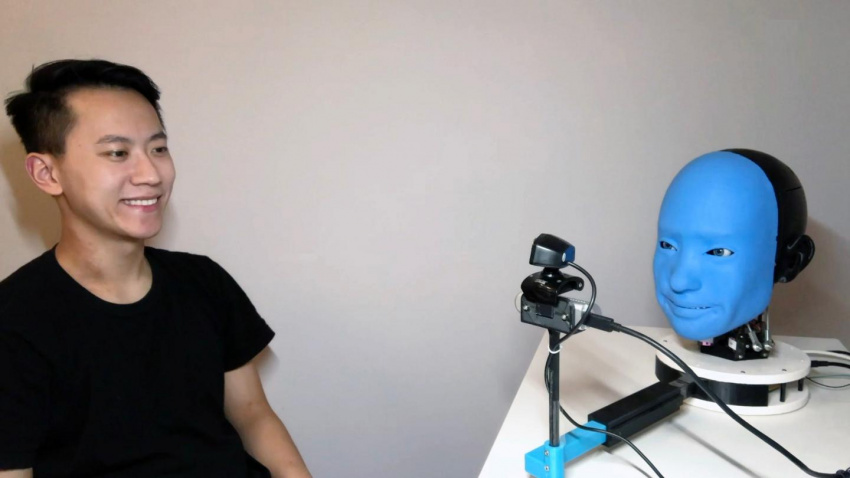The robot smiled back

New York, NY--May 27, 2021--While our facial expressions play a huge role in building trust, most robots still sport the blank and static visage of a professional poker player. With the increasing use of robots in locations where robots and humans need to work closely together, from nursing homes to warehouses and factories, the need for a more responsive, facially realistic robot is growing more urgent.
Long interested in the interactions between robots and humans, researchers in the Creative Machines Lab at Columbia Engineering have been working for five years to create EVA, a new autonomous robot with a soft and expressive face that responds to match the expressions of nearby humans. The research will be presented at the ICRA conference on May 30, 2021, and the robot blueprints are open-sourced on Hardware-X (April 2021).
"The idea for EVA took shape a few years ago, when my students and I began to notice that the robots in our lab were staring back at us through plastic, googly eyes," said Hod Lipson, James and Sally Scapa Professor of Innovation (Mechanical Engineering) and director of the Creative Machines Lab.
Lipson observed a similar trend in the grocery store, where he encountered restocking robots wearing name badges, and in one case, decked out in a cozy, hand-knit cap. "People seemed to be humanizing their robotic colleagues by giving them eyes, an identity, or a name," he said. "This made us wonder, if eyes and clothing work, why not make a robot that has a super-expressive and responsive human face?"
While this sounds simple, creating a convincing robotic face has been a formidable challenge for roboticists. For decades, robotic body parts have been made of metal or hard plastic, materials that were too stiff to flow and move the way human tissue does. Robotic hardware has been similarly crude and difficult to work with--circuits, sensors, and motors are heavy, power-intensive, and bulky.
VIDEO: https://youtu.be/1vBLI-q04kM
PROJECT WEBSITE: http://www.cs.columbia.edu/~bchen/aiface/
The first phase of the project began in Lipson's lab several years ago when undergraduate student Zanwar Faraj led a team of students in building the robot's physical "machinery." They constructed EVA as a disembodied bust that bears a strong resemblance to the silent but facially animated performers of the Blue Man Group. EVA can express the six basic emotions of anger, disgust, fear, joy, sadness, and surprise, as well as an array of more nuanced emotions, by using artificial "muscles" (i.e. cables and motors) that pull on specific points on EVA's face, mimicking the movements of the more than 42 tiny muscles attached at various points to the skin and bones of human faces.
"The greatest challenge in creating EVA was designing a system that was compact enough to fit inside the confines of a human skull while still being functional enough to produce a wide range of facial expressions," Faraj noted.
To overcome this challenge, the team relied heavily on 3D printing to manufacture parts with complex shapes that integrated seamlessly and efficiently with EVA's skull. After weeks of tugging cables to make EVA smile, frown, or look upset, the team noticed that EVA's blue, disembodied face could elicit emotional responses from their lab mates. "I was minding my own business one day when EVA suddenly gave me a big, friendly smile," Lipson recalled. "I knew it was purely mechanical, but I found myself reflexively smiling back."
Once the team was satisfied with EVA's "mechanics," they began to address the project's second major phase: programming the artificial intelligence that would guide EVA's facial movements. While lifelike animatronic robots have been in use at theme parks and in movie studios for years, Lipson's team made two technological advances. EVA uses deep learning artificial intelligence to "read" and then mirror the expressions on nearby human faces. And EVA's ability to mimic a wide range of different human facial expressions is learned by trial and error from watching videos of itself.
https://www.eurekalert.org/pub_releases/2021-05/cuso-trs052721.php


Your Comment :